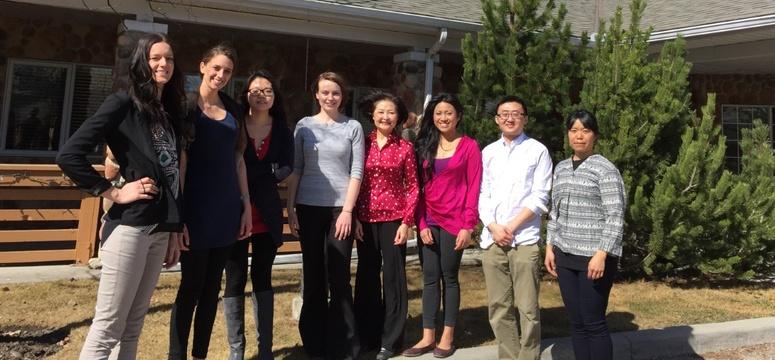
From left, Madeleine Ballantyne-Rice, Kayla Chopp, Winnie Hsiung, Lisa Evans, Tam Donnelly, Marian A
July 27, 2016

From left, Madeleine Ballantyne-Rice, Kayla Chopp, Winnie Hsiung, Lisa Evans, Tam Donnelly, Marian A
Seven second-year nursing students have had the results of their successful community development project, undertaken at an assisted living facility, published in an international journal. They were the first nursing students to partner with residents and staff at The Lodge, a residence of approximately 150 seniors in northwest Calgary.
The Journal of Gerontological Nursing featured the students’ article about their work in its June issue. The article, "A Client-Centered Community Engagement Project: Improving the Health and Wellness of Older Adults in an Assisted Living Facility," outlines how the students assessed residents and staff to gain a comprehensive perspective before they made several recommendations, also included in the article.
“Community development projects such as this one involve a collaborative approach which includes community members, organizational representatives and the health care professionals so that an understanding of the social and cultural dynamics of the community is created,” says Tam Donnelly, Faculty of Nursing professor and the students’ instructor. “Once we gain that understanding, we build on the strengths and resources that exist and encourage those community members to work together to improve their health.”
The students found that, overall, residents felt their needs had been adequately met. Suggestions for maintaining and improving their health and wellness included health education for staff and residents, support for caregivers (the spouses in most cases), management of dementia (offering peer support and creating specialized activities) and improved communication.
“It was a very positive environment, conducive to nursing students beginning to learn about community health,” says Alexandra Simon, on behalf of the group, who used a combination of windshield surveys, focus groups and key informant interviews to obtain their data. “The 30 residents we spoke to enjoyed answering our questions, and many used it as an opportunity to share their personal stories. And I think the staff were happy to be included so that we represented all opinions and points of view.”
Simon adds that the project made her and other group members more aware of the importance of social support systems — and not just for older adults. “It was apparent among the residents that supportive peers were associated with satisfaction and better mental and physical health. I felt the same for my colleagues. We were supportive and encouraging of one another and that made it a safe place to learn.
“The opportunity to improve health exists everywhere,” she continues. “With this article, we hope we portrayed how successful collaboration with individual members of a community can be achieved to promote the overall health of the group. At the same time, a healthy community can foster the health of its individual members.”
For more than 40 years, The Journal of Gerontological Nursing has published monthly, peer-reviewed original articles on the practice of gerontological nursing.